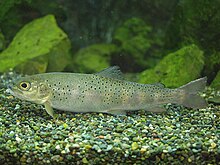
Salmonidae is a family of ray-finned fish that constitutes the only currently extant family in the order Salmoniformes. It includes salmon, trout, chars, freshwater whitefishes, graylings, taimens and lenoks, which are collectively known as the salmonids. The Atlantic salmon, whose Latin name became that of its genus Salmo, is also the eponym of the family and order names.

The Amur, or Heilong Jiang, is the world's tenth longest river, forming the border between the Russian Far East and Manchuria/Northeastern China. The Amur proper is 2,824 kilometres (1,755 mi) long, and has a drainage basin of 1,855,000 km2 (716,000 sq mi). Including its source river Argun, it is 4,444 km (2,761 mi) long. The largest fish species in the Amur is the kaluga, attaining a length as great as 5.6 metres (18 ft). The river basin is home to a variety of large predatory fish such as northern snakehead, Amur pike, taimen, Amur catfish, predatory carp and yellowcheek, as well as the northernmost populations of the Amur softshell turtle and Indian lotus.

Thymallus or graylings is a genus of freshwater salmonid ray-finned fish and the only genus within the subfamily Thymallinae. Although all Thymallus species can be generically called graylings, without specific qualification the term "grayling" typically refers to the type species Thymallus thymallus, the European grayling.
Thymallus yaluensis is a putative species of freshwater fish, a grayling in the salmon family Salmonidae. It is endemic to the upper Yalu River in Korea, on the Chinese border.
Salvelinus curilus is a species of anadromous fish in the salmon family. It inhabits the waters of Russian Far East in the Kurile Islands, Sakhalin, Primorye and also Korea and Japan. It has mostly been considered a subspecies of the Dolly Varden trout Salvelinus malma, with the name Salvelinus malma krascheninnikova, and referred to as the southern Dolly Varden or Asian southern form Dolly Varden trout.

Hucho is a genus of large piscivorous salmonid fish known as taimens, and is closely related to Pacific trout and lenoks. Native to the cold rivers and other freshwater habitats in Eurasia, they are threatened by overfishing and habitat loss.

In human mitochondrial genetics, Haplogroup D is a human mitochondrial DNA (mtDNA) haplogroup. It is a descendant haplogroup of haplogroup M, thought to have arisen somewhere in Asia, between roughly 60,000 and 35,000 years ago.

Glyptothorax is a genus of catfishes order Siluriformes of the family Sisoridae. It is the most species-rich and widely distributed genus in the family with new species being discovered on a regular basis. These species are distributed in the Black Sea basin, northern Turkey, south and east to the Yangtze River drainage in China and south throughout Indo-China to Java, Indonesia. They are found in Asia Minor and southwards to Southeast Asia. The genus is very diverse in the Indian subcontinent. Southeast Asian species tend to have restricted distributions.

The Manchurian hare is a species of hare found in northeastern China and Russia, the Amur River basin, and the higher mountains of northern North Korea. It lives in forests and the IUCN has assessed its conservation status as being of "least concern".

The houting is a European extinct species of whitefish in the family Salmonidae. It was native to the estuaries and rivers draining to the North Sea. The houting is distinguishable from other Coregonus taxa by having a long, pointed snout, an inferior mouth and a different number of gill rakers. The houting once occurred in Belgium, France, Germany, the Netherlands and England.
Neosalanx is a genus of icefishes native to Eastern Asia, ranging from Korea, through Japan and China, to Vietnam. They inhabit coastal marine waters, estuaries and river basins. There are both species that are threatened and species that are widespread.

Salmo dentex is a variety of trout, a freshwater fish in the family Salmonidae, found in the western Balkans. Until recently the identity, biological distinctness and species status of the dentex trout were not properly clarified, but genetic data now suggest it is not a monophyletic unit that could be distinguished from other salmonids as a separate species.

Lenoks, otherwise known as Asiatic trout or Manchurian trout, are salmonid fish of the genus Brachymystax, native to rivers and lakes in Mongolia, Kazakhstan, wider Siberia, Northern China and Korea.

Cyprinus rubrofuscus, the Amur carp, is a species of cyprinid fish, and is the wild form of the well-known koi. It is widespread in the fresh waters of eastern Asia, native to China, Vietnam and Laos from the Amur to Red River basins, and has also been introduced outside its native range. It is known for its muddy flavor and boniness, hence, it is not commonly eaten by locals except when stewed.

The Amur leopard is a leopard subspecies native to the Primorye region of southeastern Russia and northern China. It is listed as Critically Endangered on the IUCN Red List, as in 2007, only 19–26 wild leopards were estimated to survive in southeastern Russia and northeastern China.

Brachymystax lenok, the sharp-snouted lenok, is a salmonid fish distributed in rivers and lakes in northeastern Asia. It formerly included the blunt-snouted lenok, but recent authorities typically treat the latter as a separate species, B. tumensis, based on differences in morphology and genetics.

Li Sizhong was an ichthyologist with the Institute of Zoology (中国科学院动物研究所) at the Chinese Academy of Sciences. Throughout his research career, he made numerous discoveries of new fish species, and published many books and research papers describing the fauna and geographical distribution of fishes in China and beyond. He translated and helped publication of the Chinese editions of Fishes of the World and Fish Migration. Li was the major author of two published volumes in the Fauna Sinica monograph series, systematically reviewing and describing orders of bony fishes that include flat fish, cod, silverside, pearlfish, killifish, flying fish, etc. in or near China. He had written over 40 popular science articles about fish on Chinese newspapers and magazines, and been responsible for compiling and editing fish-related entries in several standard reference books. His works on freshwater ichthyofauna of China as well as other aspects of ichthyology are considered to be among some of the most notable in the Chinese ichthyology literature.
Amur virus (AMRV) is a zoonotic negative-sense single-stranded RNA virus. It may be a member of the genus Orthohantavirus, but it has not be definitively classified as a species and may only be a strain. It has been identified as a causative agent of hemorrhagic fever with renal syndrome.
Brachymystax savinovi is a salmonid fish species endemic to Markakol Lake and adjacent rivers in eastern Kazakhstan. It was formerly included in the more widespread species Brachymystax lenok.














